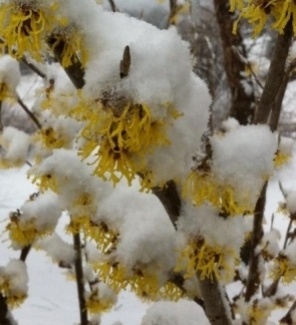
Every season that I start thinking it will be an early spring, Dad helpfully reminds me of March 1958. He was 14 years old and it had been a warm winter that year as well. Snow was not forecasted, but by the late afternoon of the 19th a heavy, wet snow was accumulating quickly. Icy tree branches snapped power lines. The heavy snow collapsed porches, sheds and barns; my Dad’s family’s barn among them. Dad remembers measuring about 48” of snow at his home.
Mom’s family had a dairy farm. The ice and wet snow blocked roadways preventing the milk trucks getting around. My grandparents had to dump at least a week’s worth of milk. Finally, they had cleared enough snow to drive the tractor and farm wagon laden with milk cans to the Buck to meet the milk truck on 272. Mom also remembers her older sister’s boyfriend was snowed in with them for about five days. They were without power for nine days and had to melt snow and cook on the fireplace in the living room.
My most memorable snowstorm was March 14, 1993. It was my junior year in high school and official reports measured 18” of snow. This storm wasn’t a wet snow like ‘58, but heavy winds caused massive drifting. Here in the Southern End, where open fields have no windbreak and many roadways are below the level of the fields, drifting was a major problem. This storm left thousands without power, made roads impassable and thrilled my brother and I with a full week of snow days and a marathon Monopoly tournament.
What is this March bringing? Last week we planted all our hanging baskets for Mother’s Day sales. Some of my workers sported bare arms and shorts as the sunny weather warmed the greenhouses. My daffodils are halfway up, the witch hazel is flowering on schedule and I’m seeing jonquils and crocus blooming in sunny city gardens. Another early favorite, the Lenten rose or Hellebores, are emerging and starting to bloom. A few local greenhouses are open, showcasing blooming pansies.
We did work on the flower beds around the farm last week. Cutting down the perennials, ornamental grasses and raking up the remainder of the leaves. It was a fun job as we discovered what plants were starting to wake up. This a great time to do a little garden clean up.
St. Patrick’s Day is next week. This is the date conventional wisdom says to get early peas and onions in the ground. Lancaster County frequently gets an “onion snow”, a light snow that melts quickly after the onions have sprouted. Also called a “sapling bender” according to the Farmers’ Almanac, this late precipitation is usually the final snow before spring arrives. We haven’t had much white stuff so far this winter 2019-2020. I’m just hoping we don’t get a repeat of ’58!
 When I get the same question twice in one week I have no choice but to write a column about it. As my sister- in-law was cleaning out her summer flower pots she noticed big tubers at the bottom of her containers. She wondered if they were safe to eat. The next day I was in at the local post office and Donna, one of the mail carriers, had a bag of Show and Tell. She pulled out the biggest sweet potato I had ever seen! She too wondered if they were edible.
When I get the same question twice in one week I have no choice but to write a column about it. As my sister- in-law was cleaning out her summer flower pots she noticed big tubers at the bottom of her containers. She wondered if they were safe to eat. The next day I was in at the local post office and Donna, one of the mail carriers, had a bag of Show and Tell. She pulled out the biggest sweet potato I had ever seen! She too wondered if they were edible. The end of September we found ourselves in Orlando, Florida for 10 days. Ostensibly, the trip was to celebrate the birthdays of our two children born 2 years and 364 days apart. We briefly visited a few friends in coastal Georgia and St. Augustine on drive down.
The end of September we found ourselves in Orlando, Florida for 10 days. Ostensibly, the trip was to celebrate the birthdays of our two children born 2 years and 364 days apart. We briefly visited a few friends in coastal Georgia and St. Augustine on drive down.
 The heat of summer is (hopefully) now behind us and my attention turned to the two containers in front of my house. This summer I planted them with butterfly-loving pentas, petunias, summer snapdragons and trailing fan flower in a color scheme of red and white. I added time release fertilizer to the soil and gave them a shot of liquid feed about once a week. We were away a week in August, and I wasn’t always Johnny On The Spot with the watering can, and they got a little too dry more than once. It is time to replant them for fall.
The heat of summer is (hopefully) now behind us and my attention turned to the two containers in front of my house. This summer I planted them with butterfly-loving pentas, petunias, summer snapdragons and trailing fan flower in a color scheme of red and white. I added time release fertilizer to the soil and gave them a shot of liquid feed about once a week. We were away a week in August, and I wasn’t always Johnny On The Spot with the watering can, and they got a little too dry more than once. It is time to replant them for fall.